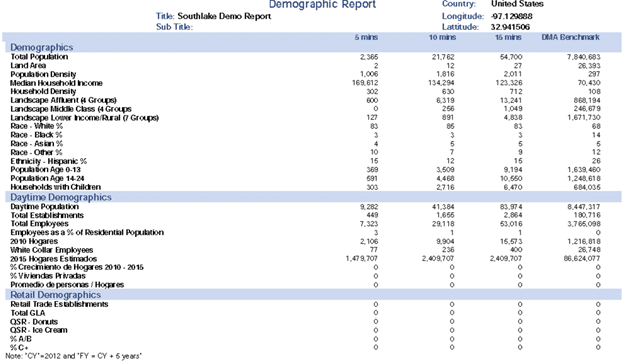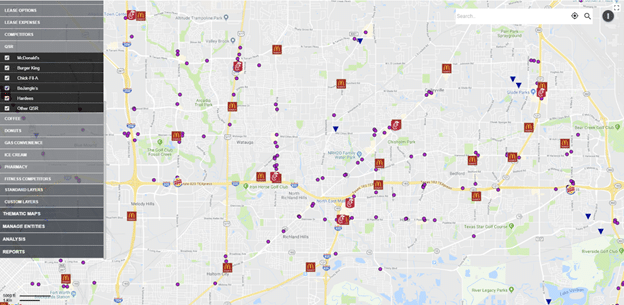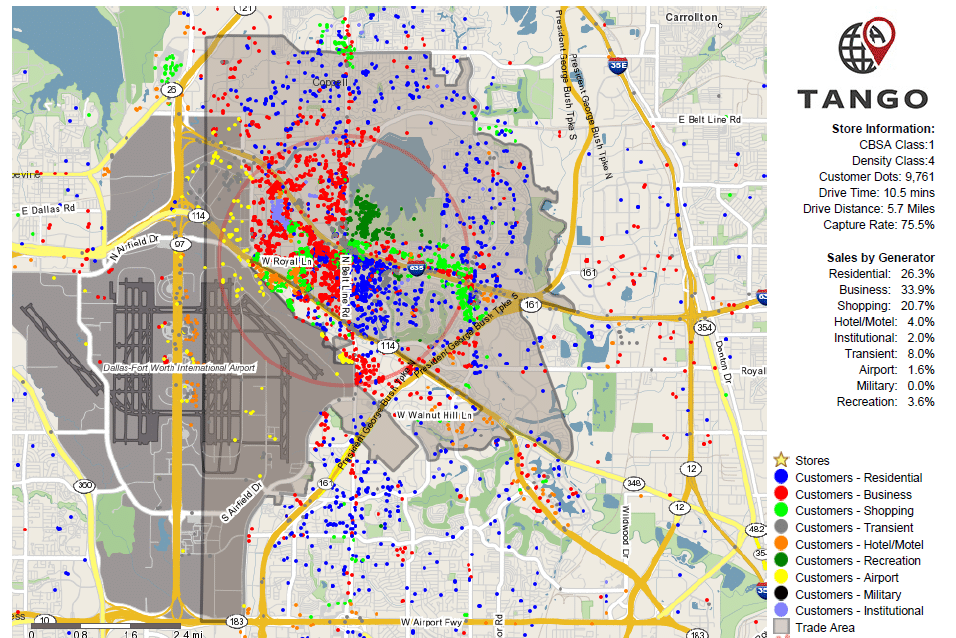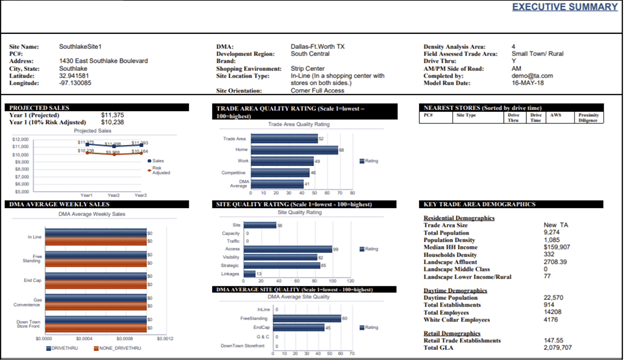Location Strategy: 5 Factors for Selecting Your Next Site
In retail, location is everything. Whether you’re running a restaurant chain or operating retail stores, your location has a massive impact on your business’ success or failure. Real estate is one of your largest operating expenses, and your location affects which market you can reach and how accessible your business will be.
Poor choices could leave you on the hook paying for a location that will never become profitable. But a well-researched site helps you expand or strengthen your business and develop thriving stores.
Successful locations don’t happen by accident. If you want to consistently make the right choices for expanding into new markets or fortifying existing ones, you need a location strategy. Your location strategy lays out the criteria you’ll use to evaluate potential sites and select the ideal placement for your next store or restaurant.
Your location strategy needs to incorporate the factors that determine who will have access to your location, how convenient that access will be, and the likely outcome of your investment.
Here are the five factors that matter most to your location strategy.
1. Demographics
If your target market is middle-class people between the ages of 14 and 24, you don’t want to develop a new site in an affluent retirement community. A good location strategy couples a clear understanding of who you intend to reach and the demographics surrounding a potential site. You want to be confident that the people who have the best access to your location are the ones your business best appeals to.
Analyzing your segmentation data and loyalty data will narrow the ideal demographics you’re looking for, giving you insight into the ages, incomes, ethnicities, and household sizes you’re best equipped to serve. The more thorough your segmentation data is, the more prepared you’ll be to forecast potential sales for your new site.
Consumers representing different demographics may come to you for different products, at different frequencies, or spend different amounts. Understanding the potential value each demographic represents will help you analyze various populations with more nuance.
It’s not enough to simply have this data. You need tools to organize and analyze it in meaningful ways. Tango Transactions is a specialized market-planning and site selection solution used by enterprises all over the world. Our tools help you leverage your proprietary customer data and give you access to a geographic information system (GIS) that empowers you to analyze the demographics of your potential site.

Since every location is a long-term investment, you also need to consider what local demographics will look like in the future. Is the population declining or growing? Are jobs bringing more people to the city? Is the area gentrifying? Any changes in demographics over time will impact your business, so as much as possible, you want to anticipate these changes and include them in your site analysis.
2. Points of interest
An ideal site puts your business in a high traffic area, where consumers already pass the building on their way to other activities. Rather than simply relying on your brand to generate traffic, you benefit from the natural traffic flows in a community. One of the key methods of gauging how well a site fits into these natural traffic patterns is by evaluating the nearby points of interest.
If a potential site is near other thriving, high-interest locations or establishments, it makes your business more visible, accessible, and appealing to the local market. Obviously, the more popular the point of interest, the more it benefits you to be in close proximity to it.
These points of interest aren’t necessarily competitors, and they may not even sell anything. You just want to identify specific places that draw people in, whether that’s a airport, restaurant, convenience store, public park, fitness center, stadium, university, or something else.
Using GIS, Tango can overlay a map of your site’s surrounding area with filters for various types of points of interest. You can identify specific kinds of facilities and even particular businesses, making it easier to see how your new site would fit into the trade area. Depending on your business, certain points of interest will be more relevant to you in the site selection process.

3. Competition
With any site, it’s crucial to consider how close you are to competitors and how that affects your potential sales. On the one hand, your new location could leech sales from your competitor’s established site, as consumers have already been trained to look for that type of product or service in that area and may be interested in an alternative, whether they’re familiar with your business or not. On the other hand, your potential sales will have a lower ceiling, as you’re sharing the trade area with your competitor(s).
Ideally, you want to identify sites surrounded by non-competing points of interest and look for opportunities to snatch up a larger share of the local market than your competitors. For example, with Tango, you can overlay your site with the traffic patterns of the surrounding area and even see the times of day where there’s the most activity. This lets you see which sites people spend the most time near, and helps you decide if you want to be closer to where most people in a local community work or where they live.

Depending on your industry, it might be more valuable to ensure your business is visible and accessible during lunch breaks or the daily commute, giving you an edge over a competing business in the same area. Or maybe people are more likely to utilize your business when they’re home, so it’s more advantageous to be closer to large residential areas than your competitors.
Another layer of complexity is cannibalization. When your locations are too close together, they compete for the same customers. Existing customers will inevitably decide the new location is more convenient or appealing, and your new site won’t only generate new sales. If too many of these sales would have already gone to your business anyways, your new site may do more harm than good.
Not all cannibalization is purely negative. Some customers may be willing to travel great distances and go out of their way to visit your business, but a more convenient location would cause them to do business with you more often. So while your current location would lose business to the new one, there’s a net gain.
In addition to increasing your market penetration, you have to consider how much a new location may compete with your existing ones. The potential loss could make your other locations unprofitable, and like competitors, your nearby locations could limit how much of the local market your new site can expect to serve.
An often overlooked aspect of cannibalization is sister store cannibalization. Sister stores aren’t your own locations, but you don’t want to treat them the same as competitors, either. You’re both subsidiaries of the same parent company, so it’s important to evaluate how your new site could impact their locations as well. While you might be eager to drive a competitor into the ground, cannibalizing a sister store’s business hurts your parent company.
4. Facility analysis
A good location strategy doesn’t just evaluate the surrounding trade area and your placement on the map. You also need to examine the building itself and consider how it will affect your business’ visibility, accessibility, and appeal. A facility can take any number of shapes and sizes, and its form will significantly impact your bottom line.
Is your store an end cap in a shopping center? Is it nestled between other related businesses? On the first floor of an office building? Part of a food court? On a school campus? When you share a wall with other points of interest and competitors, there’s obviously a lot more overlap in the market you’ll have access to. And your placement within a shopping center determines your prominence and accessibility. Do your customers have to walk past other businesses in order to see or visit yours?
Not all shopping centers are created equal, either. Your location strategy should include a system for assessing and classifying different shopping centers based on the number of “anchor” businesses, the variety of goods and services offered, and the area they’re best suited to serve.
Visibility is a crucial component of any location. Good location strategies consider how visible a facility is from main roads and walkways, the parking lot, and the shopping center (if applicable). A location in a high-traffic area becomes a lot less valuable if that traffic can’t see you. And the allure of nearby points of interest doesn’t help you as much if those buildings block visibility of your business.
You’ll also want to consider how much activity there is in the immediate vicinity. How close are you to the best trade area? And when that activity reaches its daily peak, is there enough parking to keep up, or does congestion and lack of parking spaces keep people from entering the area? What’s traffic like during these peak hours?
To put it simply, you need to evaluate whether people who want to access your business or the surrounding area will be able to do so easily. Just because a facility is visible doesn’t mean customers can access it. Poor parking, stop-and-go traffic, medians, and other obstacles have an immediate effect on the appeal and accessibility of your business.
Your location strategy should have clear criteria for assessing these physical aspects of each site.
5. Sales forecasting
Sales forecasting is where you ultimately decide on the best location. It’s where your data feeds into a model and creates a hypothesis: “if we put our store in this trade area, at this intersection, in this type of facility, with this level of accessibility, with this amount of activity, we can expect sales figures like these over time.”
Using similar locations to create a model, you can reliably forecast future sales for a site. But the key is to ensure that your model accurately represents the site you’re evaluating. And that takes a nuanced understanding of the site, the trade area, and demand. As we’ve said at Tango, “proximity to demand doesn’t mean you’re poised to serve it.” Your site needs to be where the action is if you want to capitalize on demand. Otherwise, you’re stuck waiting for the demand to move to your location—which could take years, or may never happen.
Your sales forecasting needs to accurately assess the demand a site will tap into. If you make the wrong assumptions about where local activity is and how a population behaves, your model is useless.
Good location strategies understand the relationship between using historical data to create models and incorporating intel from field representatives to ensure those models actually reflect the site under evaluation. Combining these two components is critical to reliable sales forecasting. And that’s the only way to guarantee you’ll consistently choose the best sites.
Tango Transactions makes sales forecasting a convenient, collaborative process with our Transactions module. Your team can analyze site features, visually explore the trade area with GIS capabilities, and plug site data into your models to forecast sales. You can also leverage our predictive analytics capabilities to see the future of a target site.

Simplify site selection with Tango Transactions and Tango Predictive Analytics
Tango Transactions is an all-in-one solution for managing real estate transactions and selecting your next site. Tango gives each location a site score and demographic score, so you can see at-a-glance how well it aligns with your target market and site criteria.
With Tango, you’ll have intuitive ways to utilize traditional site selection data sets, as well as more advanced capabilities that give your location strategy a leg up over the competition. Explore each trade area with the industry’s only purpose-built online GIS platform, and see the possibilities—and problems—others are missing.
Tango helps your business make smarter location decisions faster. Want to see how?
Schedule a demo of Tango Transactions and Tango Predictive Analytics.